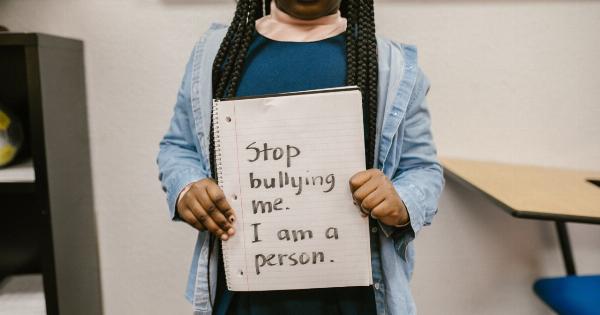Bullying in schools is a serious issue that can have long-lasting effects on the victims. It not only affects their self-esteem and mental health but also hinders their academic and social growth.
Therefore, it is crucial to address and put an end to bullying in schools. In this article, we will discuss effective strategies and actions that can help stop bullying at school.
1. Create a Safe and Supportive School Environment
The first step in stopping bullying at school is to create a safe and supportive environment where students feel comfortable and respected. This can be achieved through the following measures:.
a) Promote positive relationships among students, teachers, and staff members.
b) Establish and enforce clear anti-bullying policies that clearly define what constitutes bullying behavior and the consequences for such actions.
c) Conduct regular staff training and workshops to educate teachers and staff on how to identify and respond to bullying incidents.
d) Encourage open communication and provide multiple channels for students to report bullying anonymously.
2. Raise Awareness and Educate
Raising awareness about bullying and its consequences is crucial in preventing and stopping bullying at school. Here are some effective ways to raise awareness:.
a) Organize school-wide assemblies or events focused on bullying prevention.
b) Invite guest speakers, such as psychologists or anti-bullying advocates, to talk about the impact of bullying.
c) Incorporate anti-bullying education into the curriculum, teaching students about empathy, tolerance, and conflict resolution.
d) Share resources and information about bullying prevention with parents and the wider community.
3. Encourage Active Bystanders
One of the most effective ways to stop bullying is by empowering and encouraging active bystanders. Active bystanders are individuals who witness bullying incidents and take action to support the victim or report the incident.
Here’s how schools can encourage active bystanders:.
a) Teach students about the importance of being an active bystander and the impact they can have in stopping bullying.
b) Provide students with specific strategies and techniques they can use to intervene safely and report bullying incidents.
c) Recognize and reward students who demonstrate positive bystander behavior.
d) Foster a supportive atmosphere where students feel comfortable reporting bullying incidents without fear of retaliation.
4. Implement Peer Mediation Programs
Peer mediation programs can be highly effective in resolving conflicts and preventing bullying. Peer mediators are trained students who act as neutral third parties to help resolve conflicts between their peers.
Here’s how schools can implement peer mediation programs:.
a) Train select students to become peer mediators and equip them with conflict resolution skills.
b) Establish a designated space where students can seek the assistance of peer mediators.
c) Promote the use of peer mediation as an alternative to violence or retaliation.
d) Regularly evaluate and assess the effectiveness of the peer mediation program and make necessary improvements.
5. Provide Emotional Support for Victims
Victims of bullying often suffer from emotional distress and may require additional support. Schools should provide the necessary emotional support to help victims cope and recover. Here are some ways to provide emotional support:.
a) Train teachers and counselors to recognize signs of bullying and provide appropriate support to victims.
b) Offer counseling services and safe spaces for victims to express their feelings and concerns.
c) Foster a culture of empathy and understanding among students so that victims feel supported and validated.
d) Collaborate with external support organizations to provide additional resources for victims of bullying.
6. Collaborate with Parents and Guardians
Parents and guardians play a crucial role in addressing and preventing bullying. Schools should establish strong partnerships with parents to tackle the issue collectively. Here’s how schools can collaborate with parents and guardians:.
a) Conduct regular parent-teacher meetings to discuss bullying prevention strategies and address concerns.
b) Provide resources and educational materials for parents about recognizing and addressing bullying behavior.
c) Encourage parents to actively participate in their children’s school life and report any incidents of bullying.
d) Establish a confidential and secure reporting system for parents to communicate their concerns directly to the school.
7. Continuously Monitor and Evaluate
Stopping bullying requires an ongoing commitment and continuous monitoring. Schools should regularly assess their anti-bullying measures to ensure their effectiveness. Here’s how schools can monitor and evaluate their efforts:.
a) Collect and analyze data on bullying incidents, including frequency, location, and types of bullying.
b) Conduct anonymous surveys among students to gather feedback on the effectiveness of anti-bullying measures.
c) Review and update anti-bullying policies and strategies based on the insights gained from monitoring efforts.
d) Maintain open and transparent communication with the school community regarding progress and challenges in addressing bullying.
8. Involve the Community
Bullying prevention efforts should extend beyond the school’s boundaries and involve the wider community. Here’s how schools can engage the community:.
a) Partner with local community organizations and businesses to support anti-bullying campaigns.
b) Organize community events or workshops focused on bullying prevention.
c) Collaborate with law enforcement agencies to ensure a swift response to bullying incidents.
d) Engage local media to raise awareness about the importance of stopping bullying.
9. Lead By Example
Schools must lead by example in promoting positive behavior and creating a safe and inclusive environment. Here are some ways schools can lead by example:.
a) Ensure that teachers and staff members are consistently respectful and supportive of all students.
b) Implement school-wide initiatives that celebrate diversity and promote kindness and respect.
c) Address any issues of bullying among staff members promptly and impartially.
d) Encourage student-led initiatives that promote kindness, empathy, and inclusion.
10. Follow Up and Provide Long-Term Support
Stopping bullying is an ongoing process that requires long-term support for both victims and the entire school community. It is crucial to follow up on reported incidents and provide the necessary support.
Here’s how schools can provide long-term support:.
a) Ensure victims receive appropriate counseling and support services even after the bullying incident has been resolved.
b) Maintain regular communication with parents to address concerns and provide updates on bullying prevention efforts.
c) Organize regular workshops and educational programs to reinforce the importance of empathy, respect, and tolerance.
d) Continuously remind the school community about the zero-tolerance policy towards bullying.



























